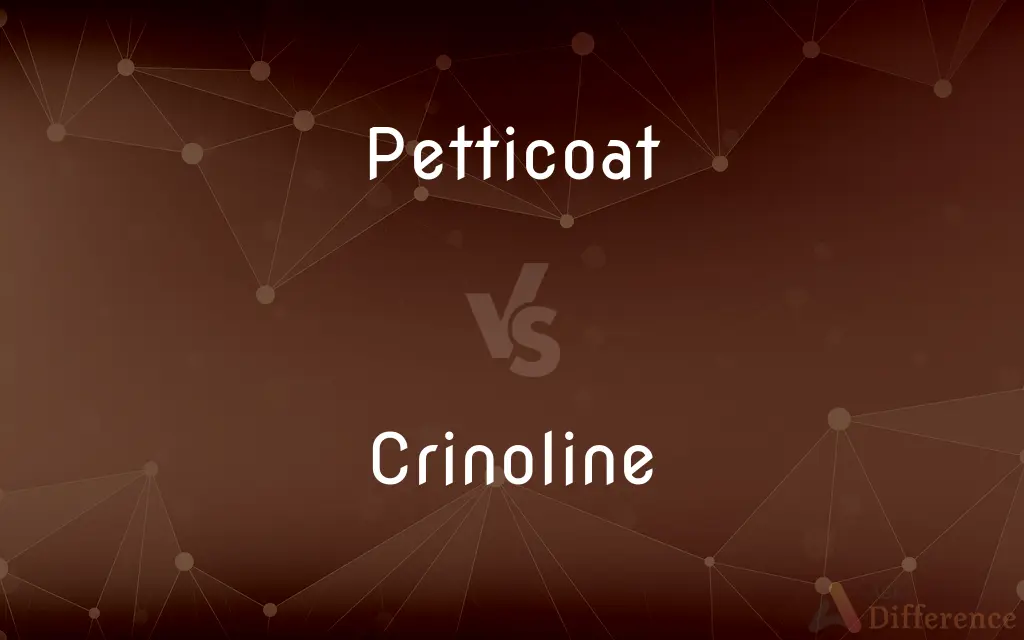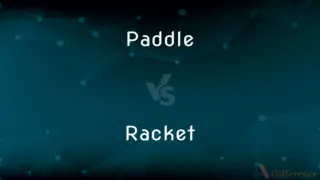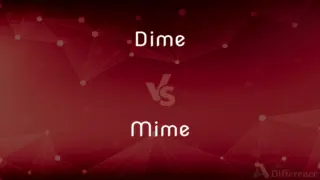Petticoat vs. Crinoline — What's the Difference?
By Maham Liaqat & Fiza Rafique — Updated on April 14, 2024
Petticoats are lightweight, often fabric undergarments used to give shape to skirts, while crinolines are structured underskirts made from stiff materials like horsehair.

Difference Between Petticoat and Crinoline
Table of Contents
ADVERTISEMENT
Key Differences
Petticoats are designed to be soft and flexible undergarments that add volume and warmth under skirts and dresses, whereas crinolines, constructed from materials like steel or horsehair, provide more rigid support and dramatic shaping.
Petticoats can be made from a variety of materials including cotton, silk, or satin, aiming for comfort and a slight boost in skirt volume. On the other hand, crinolines are typically made from stiffer materials and are designed to hold a more definite shape.
Historically, petticoats have been used since at least the 16th century to enhance the female silhouette subtly, while crinolines became popular in the 19th century, specifically to create the wide, bell-shaped skirts characteristic of that era.
In modern fashion, petticoats are often worn as part of bridal or formal wear, subtly enhancing the dress’s shape, whereas crinolines are used in costumes, historic reenactments, or fashion pieces where a pronounced skirt shape is desired.
Maintenance of petticoats generally involves simple washing and light care due to their delicate materials, while crinolines may require more specific care such as reshaping or professional cleaning to maintain their structured form.
ADVERTISEMENT
Comparison Chart
Material
Cotton, silk, satin
Horsehair, steel hoops
Purpose
Adds volume, warmth
Provides rigid skirt support
Era of Popularity
16th century onwards
Mid-19th century
Usage
Bridal, formal wear
Costumes, historic fashion
Care
Easy washing, light care
Reshaping, professional care
Compare with Definitions
Petticoat
A light, layered fabric often used for warmth.
In colder weather, women might wear a woolen petticoat for extra insulation.
Crinoline
Historically used to achieve the bell shape popular in the 19th century.
Crinolines were essential for the wide skirts of 1850s fashion.
Petticoat
Commonly used in bridal and formal fashion.
The bride chose a petticoat to give her dress the desired fullness.
Crinoline
Often made from stiff materials like steel or horsehair.
Her crinoline, stiffened with horsehair, rustled loudly as she walked.
Petticoat
Sometimes decorative, featuring lace or embroidered edges.
Her petticoat peeked out beneath her skirt, showing off intricate lace detailing.
Crinoline
Used in historical reenactments and theatrical costumes.
The actress wore a crinoline under her period costume to accurately portray a 19th-century woman.
Petticoat
Can be made in various lengths to suit different styles of clothing.
For her midi skirt, she chose a knee-length petticoat.
Crinoline
A structured underskirt made to support voluminous skirts.
The Victorian dress was supported by a large crinoline underneath.
Petticoat
An undergarment worn under a skirt or dress to increase its volume and ensure modesty.
She wore a soft silk petticoat under her gown to prevent it from being see-through.
Crinoline
Requires special care to maintain shape and cleanliness.
She had to take her crinoline to a specialty cleaner to ensure it kept its form.
Petticoat
A petticoat or underskirt is an article of clothing, a type of undergarment worn under a skirt or a dress. Its precise meaning varies over centuries and between countries.
Crinoline
A crinoline is a stiff or structured petticoat designed to hold out a woman's skirt, popular at various times since the mid-19th century. Originally, crinoline was described as a stiff fabric made of horsehair ("crin") and cotton or linen which was used to make underskirts and as a dress lining.
Petticoat
A girl's or woman's undergarment, worn under a dress or skirt, that is often full and trimmed with ruffles or lace. Also called pettiskirt.
Crinoline
A coarse stiff fabric, originally of cotton and horsehair, used especially to line and stiffen hats and garments.
Petticoat
Relating to or characteristic of women.
Crinoline
A petticoat made of this fabric.
Petticoat
(historical) A tight, usually padded undercoat worn by men over a shirt and under the doublet.
Crinoline
A hoop skirt.
Petticoat
(historical) A woman's undercoat, worn to be displayed beneath an open gown.
Crinoline
A stiff fabric made from cotton and horsehair.
Petticoat
(historical) A fisherman's loose canvas or oilcloth skirt.
Crinoline
A stiff petticoat made from this fabric.
Petticoat
A type of ornamental skirt or underskirt, often displayed below a dress; chiefly in plural, designating a woman's skirts collectively.
Crinoline
A skirt stiffened with hoops.
Petticoat
A light woman's undergarment worn under a dress or skirt, and hanging either from the shoulders or (now especially) from the waist; a kind of slip, worn to make the skirt fuller, or for extra warmth.
Crinoline
Any of the hoops making up the framework used to support cladding over a boiler.
Petticoat
(slang) A woman.
Crinoline
Netting placed around ships to guard against torpedoes.
Petticoat
(historical) A bell-mouthed piece over the exhaust nozzles in the smokebox of a locomotive, strengthening and equalising the draught through the boiler-tubes.
Crinoline
A kind of stiff cloth, used chiefly by women, for underskirts, to expand the gown worn over it; - so called because originally made of hair.
Petticoat
(transitive) To dress in a petticoat.
Crinoline
A lady's skirt made of any stiff material; latterly, a hoop skirt.
Petticoat
(dated) Feminine; female; involving a woman.
Petticoat influence
A petticoat affair
Crinoline
A skirt stiffened with hoops
Petticoat
A loose under-garment worn by women, and covering the body below the waist.
Crinoline
Full stiff petticoat made of crinoline
Petticoat
Undergarment worn under a skirt
Crinoline
A stiff coarse fabric used to stiffen hats or clothing
Common Curiosities
Can petticoats be visible under clothing?
Yes, sometimes they are decorative and meant to be slightly visible.
Are petticoats suitable for everyday wear?
They can be, especially if made from comfortable materials and not overly voluminous.
Are crinolines still used in modern fashion?
They are primarily used in costumes, historic reenactments, or specific fashion statements.
What is the difference in care between a petticoat and a crinoline?
Petticoats usually require less intensive care than crinolines, which may need reshaping or professional cleaning.
What is the primary function of a petticoat?
To add volume and warmth under skirts and dresses.
What materials are crinolines typically made from?
Stiff materials such as horsehair or steel hoops.
How do you care for a petticoat?
Petticoats generally require simple washing and are easier to maintain.
What era saw the rise of crinolines?
Crinolines became popular in the mid-19th century.
Can a petticoat be worn with any dress?
Yes, petticoats can be adapted in length and style to suit different dresses.
How do crinolines affect the shape of a dress?
They provide a rigid structure that dramatically shapes and supports voluminous skirts.
Share Your Discovery

Previous Comparison
Paddle vs. Racket
Next Comparison
Dime vs. MimeAuthor Spotlight
Written by
Maham LiaqatCo-written by
Fiza RafiqueFiza Rafique is a skilled content writer at AskDifference.com, where she meticulously refines and enhances written pieces. Drawing from her vast editorial expertise, Fiza ensures clarity, accuracy, and precision in every article. Passionate about language, she continually seeks to elevate the quality of content for readers worldwide.















































